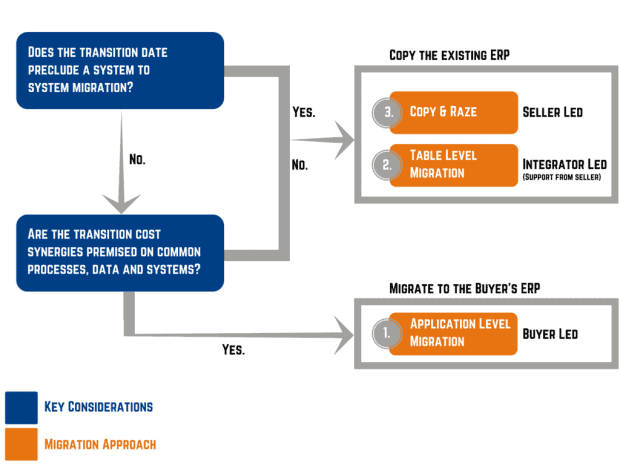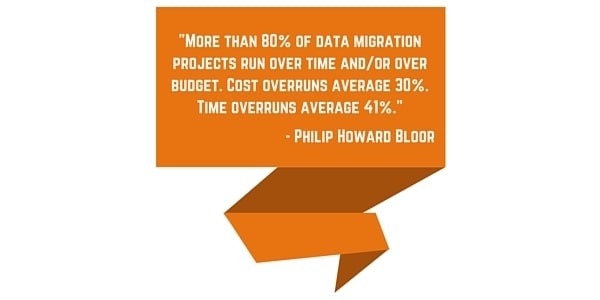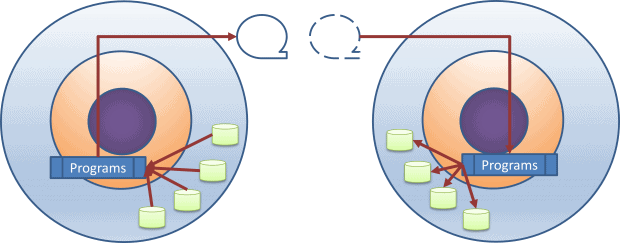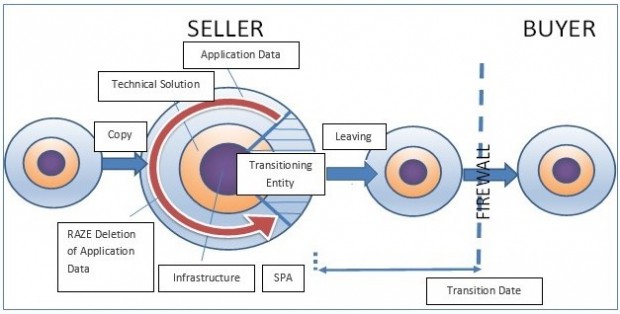Three migration approaches to drive cost synergies, facilitate the sale and mitigate transition risk during M&A

The UK is leading the way for finance-targeted mergers and acquisitions in 2016, as global M&A activity has reached its highest level, year-to-date, since 2009. Companies engaged in M&A activity are typically committed towards delivering annualised cost synergies that represent, on average, between 3-4% of the transaction value.
But what are the risks attributed to cost overrun, operational downtime during the transition and overall delays to the business transaction?
A seamless system migration is absolutely vital between buying and selling organisations. SAP® specialist Absoft has produced this blog based on a systems’ migration track record spanning across a range of industry sectors. Our blog considers three migration methodologies which ensure that core ICT business systems are in place, and operational, by the agreed transition date.

Our blog proposes that the source of cost synergies and the criticality of the transition timeline are two significant factors towards determining which migration methodology to execute.
To illustrate this point, our flowchart recommends three migration approaches based on two key questions:
- Does the transition date preclude a system to system migration?
- Are the transition cost synergies premised on common processes, data and systems?

With reference to this flowchart, our blog profiles three migration strategies and describes the circumstances in which they can be implemented effectively, based on Absoft’s own deployment track record.

Q1. Does the transition date preclude a system to system migration?
A1. Yes, the transition timeline supports a system to system migration
Q2. Are the transition cost synergies premised on common processes, data and systems?
A2. Yes, the buying organisation will extend its processes, data and systems to the new organisation
Application Data Level (ADL) Migration is typically part of an overall Extract, Transform and Load framework (ETL). Data is Extracted from one system and Transformed into a format, compatible with the destination system, before finally being Loaded into that system.
Application Data Level Migration involves the use of automated load programs that use application level logic to mimic the manual creation of data by a user – basically, this equates to very fast automated create / change data transactions.
The Application Data Level Migration approach is primarily led by the buyer, because the destination ERP system is the driver of the cost synergies and business benefits that will be derived from the transition. The seller will however, support the activity by providing extracted data.
A word of warning at this stage – which reinforces the importance of our two key questions posed in the flowchart. Consider the sobering statistics depicted below from Bloor:

Typically, the Transform Stage can cause project overrun because it encroaches on areas such as: Process Change, Change Management, Organisational Alignment and Training. All of which bring added complexity to the transition schedule.
The take-home message here is for the buying entity to ensure that they are certain the ETL project timeline is compatible with the transition date.

Q1. Does the transition date preclude a system to system migration?
A1. No, the transition timeline does not support a system to system migration
Q2. Are the transition cost synergies premised on common processes, data and systems?
A2. No, cost synergies forecast by the Buyer are not reliant on the new organisation adopting the processes, data and systems
In these circumstances, Absoft recommend a Table Level Migration (TLM). Fundamentally, this approach differs from the Application Level Data methodology in two ways: TLM has no Transform Stage (so, only Extract and Load) – and the extraction and loading of data is performed directly from and into underlying ERP tables.

The Table Level Migration approach relies on working with an integrator who has a ‘tried and tested’ set of table level migration programs, which are proven to migrate the table data fully, whilst retaining the data integrity that lies at the heart of an ERP system.
Table Level Data Migrations are quicker than the Application Level Data Migration method. This is because there is no Transform Stage, but also because the approach is not restricted by strict predecessor/successor data loading relationships that can make Application Level Data Migration both time consuming and an iterative exercise.
Absoft recently deployed its own suite of table level migration programs to assist in a franchise transition project. We assisted in migrating Maintenance and HR/Payroll data from one SAP environment into another, using Table Level Migration.
End-to-end, the process took only three weeks to create a new fit-for-purpose SAP system and migrate all the essential data from the existing to new environment.
Due to the importance of engaging with an integrator with a portfolio of ‘tried and tested’ Table Level Migration routines this approach is typified as integrator led. The seller is required to host the table extraction programs provided by the integrator. (Note: the integrator will often supply and support the destination ERP system, as part of an integrated migration project in this scenario).

Q1. Does the transition date preclude a system to system migration?
A1. No, the transition timeline does not support a system to system migration
Q2. Are the transition cost synergies premised on common processes, data and systems?
A2. No, cost synergies forecast by the Buyer are not reliant on the new organisation adopting the processes, data and systems
Copy & Raze is an alternative methodology to a Table Level Migration and the clue to how this approach works lies in the name. The seller copies their ERP system and deletes any data which is not relevant to the post-transition entity, prior to the transition date. With this approach, and incidentally, with the Table Level Migration, the buyer maintains the same ERP system.
Copy & Raze is a seller led approach as the preparation of the system for the buyer typically takes place behind the seller’s firewall. A specialised integrator may be employed to support the activity – in particular, the data deletion activity.
During the Copy & Raze Migration there is no Extract, Transform or Load stages involved – and we’ve found that the migration approach is a relatively straightforward technical exercise, which does not impact upon the transition date.

Absoft recently assisted in Copy & Raze Migration within the Transportation sector, where subsequent to the copy of the ERP system, Absoft razed commercially sensitive finance, contractual pricing data. This also included deletion of previous employee data, to comply with handling personal details, as stipulated in the Data Protection Act (1998). After the production cutover, the Copy & Razed system was handed over to the buyer, on time and within budget.

In Absoft’s experience, we have found that transition timeframes are getting shorter and shorter. As a result, both the buyer and seller is under increasing pressure to minimise any risk to the agreed transition timeline and mitigate potential disruption to post-transition operations, often by continuing to use some form of a copy of the seller’s existing business system – at least in the short to medium term.
With over twenty five years’ of supporting our customers to optimise SAP ERP systems during periods of growth and divestment, we’ve only scratched the surface in terms of the M&A capabilities offered by Absoft.
If you’d like to learn more about our M&A track record, or to discuss your experience and migration challenges, we’d be delighted to hear from you as part of our blog. Alternatively, for a confidential discussion, contact Absoft via the button below.










